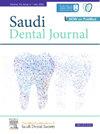Impact of printing layer thickness on the flexural strength of nanocomposite 3D printed resins: An in vitro comparative study
IF 1.7
Q3 DENTISTRY, ORAL SURGERY & MEDICINE
引用次数: 0
Abstract
Background
This study evaluated the influence of various printing layer thicknesses with silicon dioxide nanoparticles (SiO2NPs) incorporated as a reinforcement material on the flexural strength of 3D-printed denture base resins.
Material and Methods
Asiga (DentaBASE, Asiga, Erfurt, Germany) and NextDent (Denture 3D+, NextDent B.V., Soesterberg, The Netherlands) 3D-printed resins were modified with different concentrations of SiO2NPs (0.25 % and 0.5 wt%). A total of 180 specimens (bar-shaped, 64 × 10 × 3.3 mm) were fabricated (N = 90/resin). Each resin was subdivided into three groups (n = 30) according to the SiO2NP concentration (0 %, 0.25 %, and 0.5 wt%) Each concentration was divided into three groups (n = 10) according to the printing layer thickness (50 µm, 75 µm, and 100 µm). Specimens were printed according to the manufacturer’s instructions and then subjected to 10,000 thermal cycles. A three-point bending test was used to measure the flexural strength (MPa). One-way analysis of variance (ANOVA) and Tukey’s post hoc tests were used to analyze the data (α = 0.05).
Results
For both resins, printing layer thicknesses of 50 µm and 75 µm exhibited significantly higher flexural strength than 100 µm (P < 0.001). The 50 µm thickness showed the greatest flexural strength values (81.65 ± 4.77 MPa and 84.59 ± 6.21 MPa for Asiga and NextDent, respectively). The 100 µm thickness showed the lowest flexural strength values (74.35 ± 5.37 and 73.66 ± 5.55 MPa) for Asiga and NextDent, respectively. The flexural strength significantly increased with the addition of SiO2NPs with printing layer thicknesses of 50 µm and 75 µm (P < 0.001), whereas the modified and unmodified groups printed with a 100 µm layer thickness did not differ significantly. Asiga 0.25 %/50 µm and NextDent 0.5 %/50 µm showed the highest flexural strength values (97.32 ± 6.82 MPa and 97.54 ± 7.04 MPa, respectively). Scanning electron microscopy fractured surfaces analysis revealed more lamellae and irregularities with lower printing layer thicknesses and SiO2NP concentrations.
Conclusion
The flexural strength increased with printing layer thicknesses of 50 µm or 75 µm combined with SiO2NP reinforcement.
打印层厚度对纳米复合 3D 打印树脂抗弯强度的影响:体外比较研究
材料和方法 使用不同浓度的二氧化硅纳米粒子(SiO2NPs)(0.25 % 和 0.5 wt%)对 Asiga(DentaBASE,Asiga,德国埃尔富特)和 NextDent(Denture 3D+,NextDent B.V.,荷兰 Soesterberg)三维打印树脂进行改性。共制作了 180 个试样(条形,64 × 10 × 3.3 毫米)(N = 90/树脂)。根据 SiO2NP 的浓度(0%、0.25% 和 0.5 wt%),每种树脂又分为三组(n = 30);根据印刷层的厚度(50 µm、75 µm 和 100 µm),每种浓度又分为三组(n = 10)。试样按照制造商的说明进行印刷,然后进行 10,000 次热循环。三点弯曲试验用于测量弯曲强度(兆帕)。结果对于两种树脂,印刷层厚度为 50 微米和 75 微米的弯曲强度明显高于 100 微米(P < 0.001)。50 微米厚度的抗折强度值最大(Asiga 和 NextDent 分别为 81.65 ± 4.77 兆帕和 84.59 ± 6.21 兆帕)。厚度为 100 微米的 Asiga 和 NextDent 的抗折强度值最低(分别为 74.35 ± 5.37 和 73.66 ± 5.55 兆帕)。在印刷层厚度为 50 µm 和 75 µm 时,添加 SiO2NPs 后的抗折强度明显增加(P < 0.001),而印刷层厚度为 100 µm 的改性组和未改性组没有明显差异。Asiga 0.25 %/50 µm 和 NextDent 0.5 %/50 µm 的抗折强度值最高(分别为 97.32 ± 6.82 MPa 和 97.54 ± 7.04 MPa)。扫描电子显微镜断裂表面分析表明,印刷层厚度和 SiO2NP 浓度越低,层状和不规则现象越多。
本文章由计算机程序翻译,如有差异,请以英文原文为准。
求助全文
约1分钟内获得全文
求助全文
来源期刊

Saudi Dental Journal
DENTISTRY, ORAL SURGERY & MEDICINE-
CiteScore
3.60
自引率
0.00%
发文量
86
审稿时长
22 weeks
期刊介绍:
Saudi Dental Journal is an English language, peer-reviewed scholarly publication in the area of dentistry. Saudi Dental Journal publishes original research and reviews on, but not limited to: • dental disease • clinical trials • dental equipment • new and experimental techniques • epidemiology and oral health • restorative dentistry • periodontology • endodontology • prosthodontics • paediatric dentistry • orthodontics and dental education Saudi Dental Journal is the official publication of the Saudi Dental Society and is published by King Saud University in collaboration with Elsevier and is edited by an international group of eminent researchers.
 求助内容:
求助内容: 应助结果提醒方式:
应助结果提醒方式:


